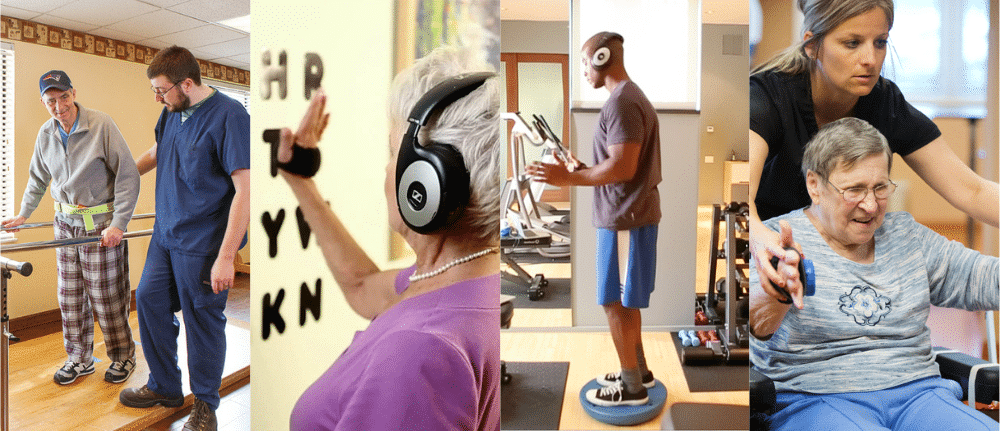
Interactive Metronome (IM) increases the rate and effectiveness of rehab interventions by synchronizing fundamental neural network communication, leading to better outcomes in the areas of cognitive, communicative, sensory, & motor function. This LIVE (interactive) certification refresher course is specifically designed for therapists and medical professionals in the adult/geriatric rehabilitation setting. The purpose is to refresh your memory regarding IM basics and to provide you with practical strategies so that you can begin incorporating IM into treatment today.
Topics will include:
- IM Fundamentals: Brief review of the nuts and bolts for those who were certified, but haven’t yet implemented IM in practice or haven’t used it in a while
- Candidacy: Which adult/geriatric patients on my caseload would benefit from IM?
- IM Assessment: How do I interpret IM scores? How do I use them to establish a treatment plan? Monitor and report progress? Know when to discontinue IM treatment?
- Documentation: How do I document IM assessment results? Write goals for IM treatment? Document IM treatment?
- IM Treatment: How do I get started? What are some considerations for my practice setting? How do I adapt and individualize IM? How much time should I spend on this each session? How many sessions are typically needed to see results? What outcomes should I expect to see?
- Fall Risk Reduction Overview: What is the role of IM in fall risk reduction? How does it differ from and improve upon current standard of care? Where do I find the IM Fall Risk Reduction treatment protocols? What evidence-based assessment tools are recommended to objectively measure results?
- Question & Answer: Bring your questions!
Upcoming Course Schedule
Seating is limited. Please register early to reserve your spot!
Saturday, February 21, 2026
Saturday, June 6, 2026
Presented by Dara Weger, MS, CCC-SLP
Dara Weger, MS, CCC-SLP received her undergraduate and master’s degree from the University of Central Arkansas and holds the Certificate of Clinical Competence issued by the American Speech-Language-Hearing Association. Dara served as the National Program Champion for Interactive Metronome within the Encompass Health Corporation. She currently serves as Interactive Metronome’s Clinical Support contact person for Encompass Health. Dara has been teaching IM Certification Courses since 2007 and has contributed to the development of the Adult Best Practice Certification Course, Fall Prevention Protocol, and Interactive Metronome’s Virtual Certification Course. With expertise and experience in the field of neurological disorders, Dara has been able to accept this new treatment tool and successfully integrate it into her practice by modifying it to individually meet her patient’s needs.
Target Audience:
This course welcomes the following professionals who have completed the Interactive Metronome Certification Course.
- Speech and Language Pathologist
- Speech and Language Pathology Assistant
- Occupational Therapist
- Occupational Therapy Assistant
- Physical Therapist
- Physical Therapy Assistant
- Athletic Trainer
- Licensed Medical, Rehabilitation or Mental Health Professional
- Music Therapist
Learning Outcomes:
Upon completion of this course, participants will be able to:
- Describe the central role of timing and rhythmicity to occupational performance, include temporal integration research and evidence.
- Describe and demonstrate the application of interactive time-skills training technologies on performance-based treatment environments.
- List a minimum of 3 criteria for selecting adult/geriatric candidates for time-skills training applied within the context of functional activities.
- Demonstrate sequential knowledge of setting up and applying time-skills training technologies.
- Describe time-skills data collection including scoring, assessment and progress monitoring.
- List at least 3 considerations for documenting time-skills functional assessment and applying time-skills performance at the millisecond level within occupation-based goals.
- Explain at least 10 methods for grading time-skills training activities to address areas of functional challenge.
- Describe a minimum of 3 areas of impact when timing & rhythm training is included in fall risk assessment and intervention.
- List 3 evidence-based tools for fall risk assessment.
*Note: This course covers information that pertains to licensed therapists and therapy assistants. OTA and PTA professionals must practice IM under the supervision of a licensed OT or PT.
Specific Learning Outcomes for Speech-Language Pathologists & Audiologists:
- Describe the steps in sequence for setting up IM equipment for use with patients;
- List at least 3 criteria for selecting adult/geriatric candidates for IM treatment in order to improve speech, language and cognitive-communicative skills;
- Locate IM reports and scores, and refer to Indicator Table for normative comparison;
- Describe at least 3 considerations for documenting IM assessment and establishing measurable therapy goals for the treatment of speech, language and cognitive-communicative impairments;
- List 10 settings that may be adjusted to individualize IM treatment (Exercise, Time, Reps, Volume, Guide Sounds on/off, Tempo, Difficulty, SRO setting, Burst Threshold, Training Visuals);
- List at least 3 areas of impact by the IM Fall Risk Reduction program that are in within the scope of Speech-Language Pathology practice and explain how this approach differs from that currently being deployed in healthcare settings;
- Name at least 3 evidence-based tools for fall risk assessment that may be administered by the Speech-Language Pathologist.
*Note: This course covers information that pertains to licensed therapists and therapy assistants. SLPA professionals must practice IM under the supervision of a licensed SLP.


